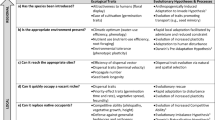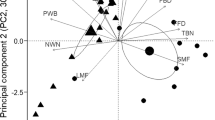Abstract
Contemporary anthropogenic evolution is common. Biological invasions are an especially dynamic form of novel selection. This paper considers how native species evolve in response to biological invasions and the potential consequences of such evolution. Among numerous recent cases, the most widely reported instances are of phytophagous insects shifting onto introduced host plants. For example, our studies show that in North America and Australia, soapberry bugs evolved substantially after colonizing introduced hosts. Such cases permit close estimation of evolution’s direction and rate, and we have used cross-rearing studies of derived and ancestral-type populations to measure changes in reaction norms and performance tradeoffs. Different fitness traits have followed very different paths in evolving to their current phenotypic values. Our hybridization studies show that the genetic architecture of these adaptations involves a surprising degree of non-additive variation (epistasis, dominance). The importance of non-additive genetic variation in rapid evolution will be clarified as more studies take advantage of similar situations. As appreciation grows for the deep contemporary interplay of evolution and ecology, debate about qualitative terms describing evolution’s rate will become less relevant. From a conservation standpoint, contemporary evolution in native species presents challenges for ecologically appropriate and sustainable management. Evolving natives and invaders may reconfigure contemporary and future communities. Adaptive evolution may also enhance native communities’ capacity to control invasive populations.
Similar content being viewed by others
References
Agrawal AA, Kotanen PM (2003) Herbivores and the success of exotic plants: a phylogenetically controlled experiment. Ecol Lett 6:712–715
Agrawal AA, Kotanen PM, Mitchell CE, Power AG, Godsoe W, Klironomos J (2005) Enemy release? An experiment with congeneric plant pairs and diverse above- and below-ground enemies. Ecology 86:2979–2989
Badyaev AV, Foresman KR, Young RL (2005) Evolution of morphological integration: developmental accommodation of stress-induced variation. Am Nat 166:382–395
Batianoff GN, Butler DW (2002) Assessment of invasive naturalized plants in south-east Queensland. Plant Prot Q 17:27–34
Burke MW, Grime JP (1996) An experimental study of plant community invasibility. Ecology 776–790
Bush GL (1969) Sympatric host race formation and speciation in frugivorous flies of genus Rhagoletis (Diptera, Tephritidae). Evolution 23:237–251
Callaway RM, Ridenour WM (2004) Novel weapons: invasive success and the evolution of increased competitive ability. Front Ecol Environ 2:436–443
Carroll SP (2007) Brave new world: the epistatic foundations of natives adapting to invaders. Genetica 129:193–207
Carroll SP, Boyd C (1992) Host race radiation in the soapberry bug—natural history with the history. Evolution 46:1052–1069
Carroll SP, Dingle H (1996) The biology of post-invasion events. Biol Conserv 78:207–214
Carroll SP, Dingle H, Famula TR (2003a) Rapid appearance of epistasis during adaptive divergence following colonization. Proc R Soc B Biol Sci 270:S80–S83
Carroll SP, Dingle H, Famula TR, Fox CW (2001) Genetic architecture of adaptive differentiation in evolving host races of the soapberry bug, Jadera haematoloma. Genetica 112:257–272
Carroll SP, Dingle H, Klassen SP (1997) Genetic differentiation of fitness-associated traits among rapidly evolving populations of the soapberry bug. Evolution 51:1182–1188
Carroll SP, Klassen SP, Dingle H (1998) Rapidly evolving adaptations to host ecology and nutrition in the soapberry bug. Evol Ecol 12:955–968
Carroll SP, Loye JE, Dingle H, Mathieson M, Famula TR, Zalucki MP (2005a) And the beak shall inherit—evolution in response to invasion. Ecol Lett 8:944–951
Carroll SP, Loye JE, Dingle H, Mathieson M, Zalucki MP (2005b) Ecology of Leptocoris Hahn (Hemiptera: Rhopalidae) soapberry bugs in Australia. Aust J Entomol 44:344–353
Carroll SP, Loye JE, Dingle H, Mathieson M, Zalucki MP (2006) Erratum: ecology of Leptocoris Hahn (Hemiptera: Rhopalidae) soapberry bugs in Australia (vol 44, 344, 2005). Aust J Entomol 45:185–185
Carroll SP, Marler M, Winchell R, Dingle H (2003b) Evolution of cryptic flight morph and life history differences during host race radiation in the soapberry bug, Jadera haematoloma Herrich-Schaeffer (Hemiptera: Rhopalidae). Ann Entomol Soc Am 96:135–143
Carroll SP, Mathieson M, Loye JE (2005c) Invasion history and ecology of the environmental weed balloon vine, Cardiospermum grandiflorum Swartz, in Australia. Plant Prot Q 20:140–144
Colautti RI, Ricciardi A, Grigorovich IA, MacIsaac HJ (2004) Is invasion success explained by the enemy release hypothesis? Ecol Lett 7:721–733
Cox GW (2004) Alien species and evolution. Island Press, Washington DC
Crooks JA (2002) Characterizing ecosystem-level consequences of biological invasions: the role of ecosystem engineers. Oikos 97:153–166
Davis MA, Grime JP, Thompson K (2000) Fluctuating resources in plant communities: a general theory of invasibility. J Ecol 88:528–534
Davis MA, Thompson K (2000) Eight ways to be a colonizer; two ways to be an invader: a proposed nomenclature scheme for invasion ecology. Bull Ecol Soc Am 81:226–230
Diamond JM (1989) Overview of recent extinctions. In: Western D, Pearl MC (eds) Conservation for the twenty-first century. Oxford University Press, Oxford
Dres M, Mallet J (2002) Host races in plant-feeding insects and their importance in sympatric speciation. Philol Trans R Soc Lond B Biol Sci 357:471–492
Elton CS (1958) The ecology of invasions by animals and plants. Methuen and Co., Ltd, London
Fagan WF, Lewis M, Neubert MG, Aumann C, Apple JL, Bishop JG (2005) When can herbivores slow or reverse the spread of an invading plant? A test case from Mount St. Helens Am Nat 166:669–685
Fargione JE, Tilman D (2005) Diversity decreases invasion via both sampling and complementarity effects. Ecol Lett 8:604–611
Fenner F, Ratcliffe FN (1965) Myxomatosis. Cambridge University Press, Cambridge, UK
Filchak KE, Roethele JB, Feder JL (2000) Natural selection and sympatric divergence in the apple maggot Rhagoletis pomonella. Nature 407:739–742
Fritts TH, Rodda GH (1998) The role of introduced species in the degradation of island ecosystems: a case history of Guam. Ann Rev Ecol Syst 39:113–140
Ghalambor CK, McKay JK, Carroll SP, Reznick DN (2007) The good, the bad and the ugly: phenotypic plasticity and adaptation to new environments. Funct Ecol (in press)
Grether GF (2005) Environmental change, phenotypic plasticity, and genetic compensation. Am Nat 166:E115–E123
Hairston NG, Ellner SP, Geber MA, Yoshida T, Fox JA (2005) Rapid evolution and the convergence of ecological and evolutionary time. Ecol Lett 8:1114–1127
Hartman KM, McCarthy BC (2004) Restoration of a forest understory after the removal of an invasive shrub, Amur honeysuckle (Lonicera maackii). Restor Ecol 12:154–165
Joshi J, Vrieling K (2005) The enemy release and EICA hypothesis revisited: incorporating the fundamental difference between specialist and generalist herbivores. Ecol Lett 8:704–714
Keane RM, Crawley MJ (2002) Exotic plant invasions and the enemy release hypothesis. Trends Ecol Evol 17:164–170
Kiesecker JM, Blaustein AR (1997) Population differences in responses of red-legged frogs (Rana aurora) to introduced bullfrogs. Ecology 78:1752–1760
Kowarik I (1995) Time lags in biological invasions with regard to the success and failure of alien species. In: Pysek P, Prach K, Rejmanek M, Wade M (eds) Plant invasions: general apsects and special problems. SPB Academic Publishing, Amsterdam, The Netherlands
Lambrinos JG (2004) How interactions between ecology and evolution influence contemporary invasion dynamics. Ecology 85:2061–2070
Lee CE (2002) Evolutionary genetics of invasive species. Trends Ecol Evol 17:386–391
Levine JM, Adler PB, Yelenik SG (2004) A meta-analysis of biotic resistance to exotic plant invasions. Ecol Lett 7:975–989
Losos JB, Schoener TW, Spiller DA (2004) Predator-induced behaviour shifts and natural selection in field-experimental lizard populations. Nature 432:505–508
Malausa T, Bethenod MT, Bontemps A, Bourguet D, Cornuet JM, Ponsard S (2005) Assortative mating in sympatric host races of the European corn borer. Science 308:258–260
Mitchell CE, Agrawal AA, Bever JD, Gilbert GS, Hufbauer RA, Klironomos JN, Maron JL, Morris WF, Parker IM, Power AG, Seabloom EW, Torchin ME, Vazquez DP (2006) Biotic interactions and plant invasions. Ecol Lett 9:726–740
Moran VC (1980) Interactions between phytophagous insects and their Opuntia hosts. Ecol Entomol 5:153–164
Nosil P, Crespi BJ, Sandoval CP (2006) The evolution of host preference in allopatric versus parapatric populations of Timema cristinae walking-sticks. Evol Biol 19:929–942
Palumbi SR (2001) The evolution explosion: how humans cause rapid evolution change. W.W. Morton, New York, USA
Parchman TL, Benkman CW (2002) Diversifying coevolution between crossbills and black spruce on Newfoundland. Evolution 56:1663–1672
Parker IM, Simberloff D, Lonsdale WM, Goodell K, Wonham M, Kareiva PM, Williamson MH, Von Holle B, Moyle PB, Byers JE, Goldwasser L (1999) Impact: toward a framework for understanding the ecological effects of invaders. Biol Invasions 1:3–19
Phillips BL, Brown GP, Webb JK, Shine R (2006) Invasion and the evolution of speed in toads. Nature 439:803
Regan JL, Meffert LM, Bryant EH (2003) A direct experimental test of founder-flush effects on the evolutionary potential for assortative mating. J Evol Biol 16:302–312
Rehder A (1947) Manual of cultivated trees and shrubs hardy in North America. Macmillan, New York
Rejmanek M, Rejmankova E, Holzner W (2004) Species diversity of plant communities on calcareous screes: the role of intermediate disturbance. Preslia 76:207–222
Reznick DN, Ghalambor CK (2001) The population ecology of contemporary adaptations: what empirical studies reveal about the conditions that promote adaptive evolution. Genetica 112:183–198
Reznick DN, Rodd H, Nunney L (2004) Empirical evidence for rapid evolution. In: Ferriere R, Dieckmann U, Couvet D (eds) Evolutionary conservation biology, Cambridge University Press, Cambridge, UK, pp 101–118
Reznick DN, Shaw FH, Rodd FH, Shaw RG (1997) Evaluation of the rate of evolution in natural populations of guppies (Poecilia reticulata). Science 275:1934–1937
Richardson DM, Pysek P, Rejmanek M, Barbour MG, Panetta D, West CJ (2000) Naturalization of alien plants: concepts and definitions. Divers Distrib 6:93–107
Rodland DL, Bottjer DJ (2001) Biotic recovery from the end-Permian mass extinction; behavior of the inarticulate brachiopod Lingula as a disaster taxon. Palaios 16:95–101
Schwarz D, Matta BM, Shakir-Botteri NL, McPheron BA (2005) Host shift to an invasive plant triggers rapid animal hybrid speciation. Nature 436:546–549
Siegler DS, Kawahara W (1976) New reports of cyanolipids from sapindaceous plants. Biochem Syst Ecol 4:263–265
Siemann E, Rogers WE (2003) Reduced resistance of invasive varieties of the alien tree Sapium sebiferum to a generalist herbivore. Oecologia 135:451–457
Singer MC, Thomas CD, Parmesan C (1993) Rapid human-induced evolution of insect host associations. Nature 366:681–683
Smith TB, Freed LA, Lepson JK, Carothers JH (1995) Evolutionary consequences of extinctions in populations of a hawaiian honeycreeper. Conserv Biol 9:107–113
Stastny M, Schaffner U, Elle E (2005) Do vigour of introduced populations and escape from specialist herbivores contribute to invasiveness? J Ecol 93:27–37
Stockwell CA, Hendry AP, Kinnison MT (2003) Contemporary evolution meets conservation biology. Trends Ecol Evol 18:94–101
Strauss SY, Lau JA, Carroll SP (2006a) Evolutionary responses of natives to introduced species: what do introductions tell us about natural communities? Ecol Lett 9:357–374
Strauss SY, Webb CO, Salamin N (2006b) Exotic taxa less related to native species are more invasive. Proc Natl Acad Sci USA 103:5841–5845
Tabashnik BE (1983) Host range evolution—the shift from native legume hosts to alfalfa by the butterfly, Colias philodice-eriphyle. Evolution 37:150–162
Thomas CD, Ng D, Singer MC, Mallet JLB, Parmesan C, Billington HL (1987) Incorporation of a European weed into the diet of a North American herbivore. Evolution 41:892–901
Thompson JN (1998) Rapid evolution as an ecological process. Trends Ecol Evol 13:329–332
Vermeij GJ (1996) An agenda for invasion biology. Biol Conserv 78:3–9
Wolfe LM, Elzinga JA, Biere A (2004) Increased susceptibility to enemies following introduction in the invasive plant Silene latifolia. Ecol Lett 7:813–820
Yoshida T, Jones LE, Ellner SP, Fussmann GF, Hairston NG (2003) Rapid evolution drives ecological dynamics in a predator-prey system. Nature 424:303–306
Acknowledgments
I especially thank the symposium organizers who invited me to participate: Drs. M. Ishihara, F. Ishihama, S. Kudo, K. Goka and T. Yoshida. In addition, I thank the Japanese Ecological Society for supporting my travel and expenses to the meeting and while in Japan, and the membership of the Japanese Ecological Society for hospitality during the meeting. K. Fujisaki, S. Nishida and T. Nishida provided additional hospitality after the meeting, as did the students of all these individuals during and after the meeting. The United States National Science Foundation, the Australian–American Fulbright Commission, the University of California, Davis, and Carroll-Loye Biological Research supported the research.
Author information
Authors and Affiliations
Corresponding author
About this article
Cite this article
Carroll, S.P. Natives adapting to invasive species: ecology, genes, and the sustainability of conservation. Ecol Res 22, 892–901 (2007). https://doi.org/10.1007/s11284-007-0352-5
Received:
Accepted:
Published:
Issue Date:
DOI: https://doi.org/10.1007/s11284-007-0352-5




